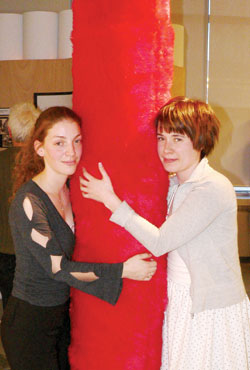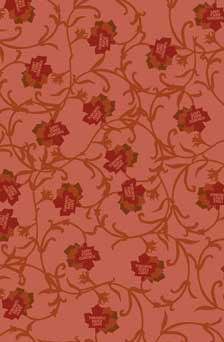Objects infused with artistic inspiration
Show covers a range of media, with projects from kitsch to ergonomics

Hug-A-Lug was designed by second-year students (from left) Juliana Berger, Julie Mancini and Clayton Blackman (who had already returned home to Vancouver) to help visually impaired children learn to stand and navigate obstacles effectively. The padded form rides on a ceiling track.
Photo by marc losier
Design students showed how inspiration translates into objects at in[FUSE]. The show ran from April 18 to 23 on the seventh floor of the EV Building.
Second-year student Julie Mancini was responsible for putting the exhibit together. She helped with last year’s event. “The show used to be just for first- and second-year students,” Mancini said. “Last year, we decided to expand the exhibit for all three years.”
In[Fuse] was intended to demonstrate how students’ ideas are triggered by the things around them.
First-year student Olivia Ho’s Mundane is Beautiful was based on the naive wonder depicted by Audrey Tautou in the film Amélie. Ho created a poster of sharp, colour-saturated, close-up photographs of everyday objects like crackers, straws, pasta, candy, fishnet stockings and the cane webbing of a chair.
Graduating student Colin Huggard used the kitsch featured in Douglas Coupland’s books on Canadian design to develop a series of wallpapers.

Colin Huggard's wallpaper designs play up Canadian kitsch. Huggard is also helping to mount Exposed.
From a distance, the patterns suggest the mannered colours and styles of William Morris’s Arts & Crafts movement, but closer inspection revealed Canadian Tire and Toronto Maple Leafs logos intertwined in the designs.
Mancini displayed about half of the 86 projects that were submitted for exhibition. “I was pleased that so many people chose to be involved, and by the quality of the work,” she said.
Selection was left up to a jury of former students and a faculty member who evaluated each entry’s originality, creativity, aesthetics and how well it captured the original inspiration.
Equally impressive was the range of materials and expertise needed to realize projects ranging from an ergonomic wood and metal writing desk to interactive digital displays, bound volumes and stitched projects.
The design program includes training in skills as diverse as bookbinding and metalwork.
“We have to do everything from first plans to the final stage. It’s all done by hand.”
Some work is done in a workshop. While technicians oversee certain aspects of construction, students are expected to produce detailed plans for their projects. “We have to show that we’re prepared going in,” Mancini said.
Students in the Department of Design and Computation Arts also organize an annual show for their 60 graduating students. That exhibit, Exposed, started on May 2 and will run until May 7. The vernissage is May 4, from 7 to 11 p.m. on the 7th floor of the EV Building.